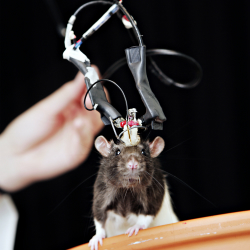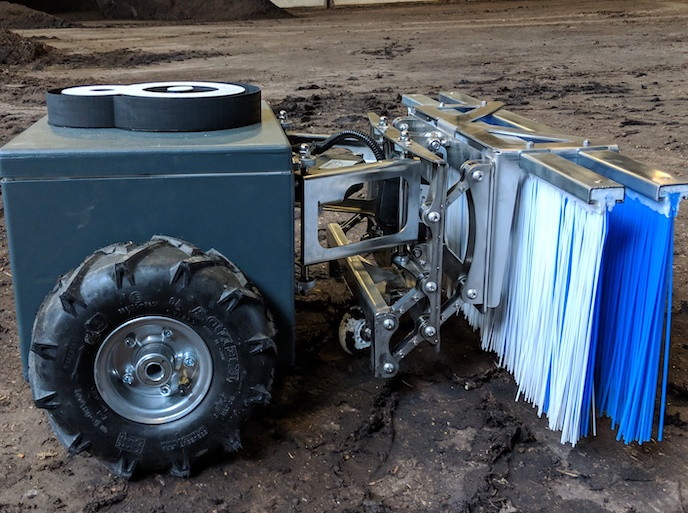Brain-inspired navigation in robots
Computers are undoubtedly a step ahead when it comes to processing enormous amounts of information with precisely-instructed algorithms and within short timeframes. However, to this day they still lack the capacity to efficiently compute ambiguous and unpredictable data: the latter requires the algorithm to be updated frequently, something that only the human brain — which is known for being about 30 times more powerful than the best computer chip — is able to do efficiently. One of the best examples of this computer limitation resides in navigation. Whilst our brain can easily help us navigate through dynamically changing environments, ‘Simultaneous localisation and mapping systems’ (SLAMs) will perform poorly, especially when taking into account the tremendous amount of computations and memory involved in the process. ‘In traditional computers, much of this process is serial, in the sense that the computer will do one thing at a time,’ says Dr Edvard Moser, coordinator of the EU-backed GRIDMAP (Grid cells: From brains to technical implementation) project. ‘In the brain on the other hand, many processes take place at the same time and it’s all interactive: what takes place in one region of the brain takes into account what is going on at the same time in another region.’ This is where Dr Moser’s most documented discovery comes into play. In 2005, he and his team at the Centre for the Biology of Memory (CBM) in Norway discovered grid cells, a type of neuron in the brains of many animal species that allows them to understand their position in space. The main premise of GRIDMAP is that this process can be studied, translated into algorithms and integrated into machines to enable brain-like navigation in complex environments. ‘We wanted to know more about how the brain works,’ Dr Moser recalls. ‘We started by studying the brain, thinking that its processes could also be used in computers, and especially robots. The idea was that if we could know more about the mechanisms behind brain navigation, what types of cells are involved and how they work together, this could then be used by engineers who produce artificial systems such as robots to advance the state-of-the-art.’ In its first phase, the team focused on studying how grid cells work together. ‘For example, if a rat is walking in a box 2 m2, its brain cells may be active in 10-12 different locations. From thereon in, there is a complex process taking place that involves a lot of physics, but the bottom line is that these active cells compete with each other and that the activity pattern emerges as a result of this competition. It emerges because it is the most stable pattern,’ Dr Moser explains. Since the project began in March 2013, the team have been using a measurement tool to better understand this process. They recorded the electrical activity of animal brain cells with electrons that capture ongoing electrical activity without damaging the cell, and then recorded this information on a computer in order to determine how the cells work together to form a map of the environment surrounding the animal. ‘For that work, we collaborate with computation specialists in order to develop models of how things could work. Those models are basically predictions, so we check if those predictions are right, and then, depending on the outcome, the models are adjusted,’ says Dr Moser. From brain to machine This long research process, which was originally scheduled for completion in August 2016, will last for at least another year. Dr Moser and his team have recently been granted a one-year extension for GRIDMAP, which will provide them with the time needed to successfully conduct the technical implementation phase. ‘We are now trying to implement connectivity patterns, similar to the ones we observed in the brain, into computers and then see if, somehow, that enables robust navigation in robots. But there is still a long way to go if we want to understand precisely how the brain works and how to implement these mechanisms into machines,’ Dr Moser says. ‘What is needed is a technical implementation of a situation where a robot finds its way in an environment where many unexpected things happen, for example the need for taking an improvised shortcut to avoid an obstacle in a unknown environment. We are looking at such situations in animals too, but still it is hard to figure out. Moreover, the progress in biological research is much slower than perhaps what the robotics industry would expect. I think drawing inspiration from biological processes is the right way to go, but it takes time.’ Dr Moser and his team very recently started to implement some of the principles they found in brains into computers. While he says that the results already look promising, he admits that the point where GRIDMAP translates into commercial products is far from being reached. The research will most likely continue after the end of the project, but he believes this will eventually prove worthwhile: navigation is one of the properties that the robotics industry is most interested in, and GRIDMAP is presenting them with more potential than any alternative.







